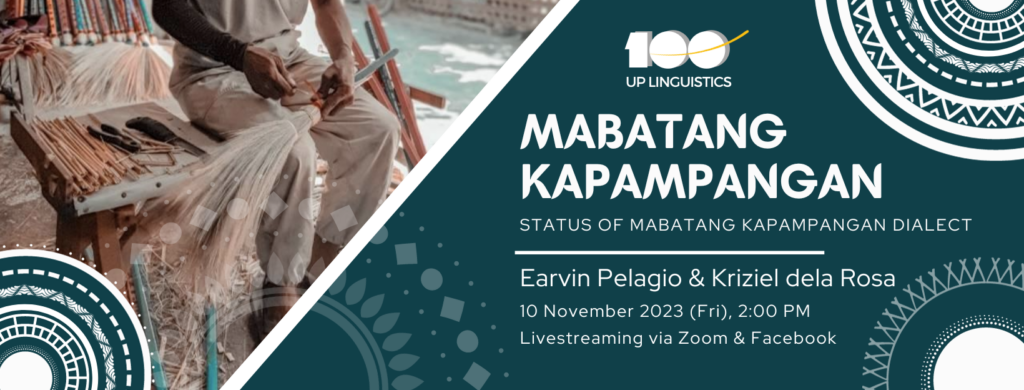Mabatang-Kapampangan | Philippine Indigenous Languages Lecture Series
- Date: 10 Nov 2023 | 2:00 PM - 3:00 PM

Status of Mabatang Kapampangan Dialect
Philippine Indigenous Languages Lecture Series (PILLS)
10 November 2023 | 2:00 PM | Zoom and Livestreaming via Facebook
The eleventh installment of PILLS will be presented by MA Linguistics student, Earvin Pelagio and BA Linguistics alumna, Kriziel dela Rosa. In this lecture, Pelagio and dela Rosa will talk about a dialect of Kapampangan spoken in Brgy. Mabatang, situated at Abucay, Bataan.
ABSTRACT
The speech community of Kapampangan in Brgy. Mabatang (Mabatang-Kapampangan) is unique due to its location and history. Mabatang-Kapampangan is situated within the province of Bataan, a Tagalog-majority area, and has been dubbed as a Kapampangan island in a sea of Tagalog (Del Corro, 1988, p. 5). Its relative isolation to other Kapampangan speech community has led to it retaining features documented in Spanish-era dictionaries and grammars such as word-final diphthongs and several ‘archaic’ lexicon, making the Mabatang-Kapampangan dialect a relic area (Cruz, et al, 2020).
In this study we assessed the vitality status of Mabatang-Kapampangan using the Expanded Intergenerational Disruption Scale (EGIDS) and the Sustainable Use Model (SUM) Assessment Grid developed by Simons and Lewis (2012). For our analysis, we considered the Mabatang-Kapampangan speech community as a distinct unit. Thus, the language situation of Kapampangan in Pampanga was not considered especially because Mabatang-Kapampangan has little to no regular interaction with other Kapampangan speech communities.
We found that Mabatang-Kapampangan has an EGIDS level of 6b (Threatened) showing that it is susceptible to shift towards Tagalog. Mabatang-Kapampangan’s vitality status can be attributed to a Tagalog-focused education system, intense contact with Tagalog, and a general lack of government support. In contrast, Kapampangan is listed as having an EGIDS level of 3 (Wider Communication) (Eberhard, Simons, and Fennig, 2022). These contrasting EGIDS level suggest that speech communities can have varying degrees of vitality and/or endangerment and highlights the importance of doing localized assessments for studies or projects focusing on specific communities.
Image sourced from Tuklas Bataan (link to original image post: https://www.facebook.com/…/a.529317760…/736311980220444/)
